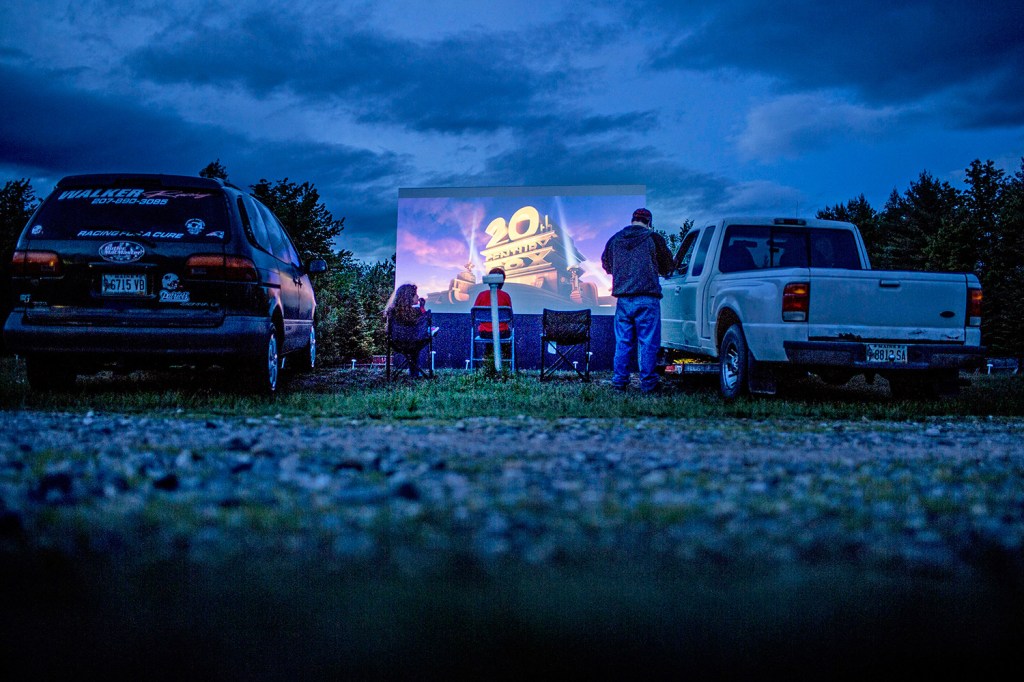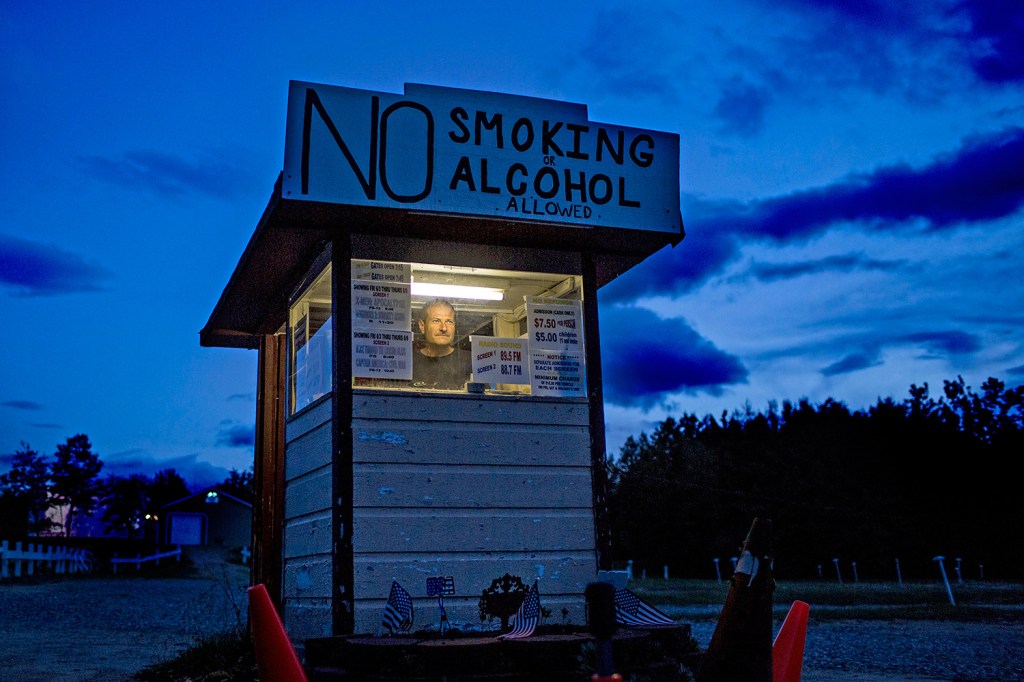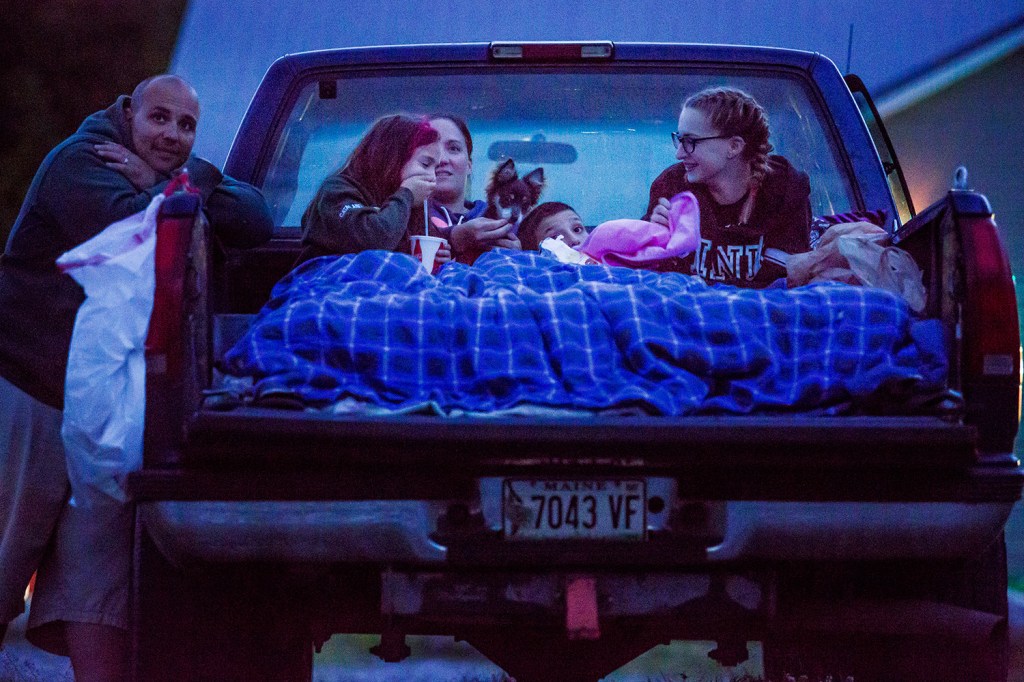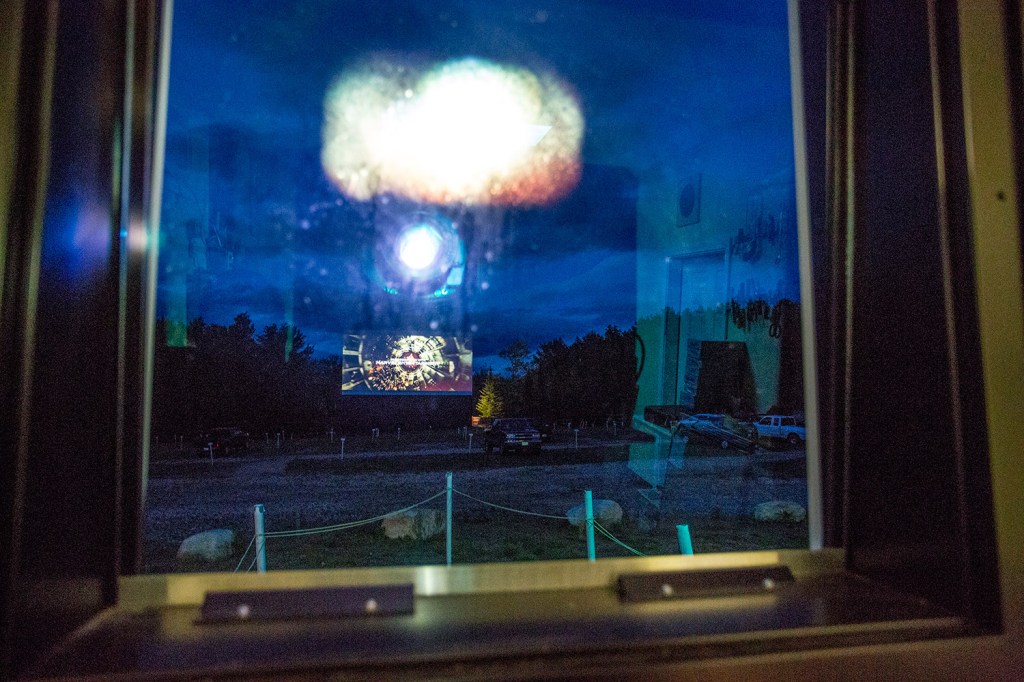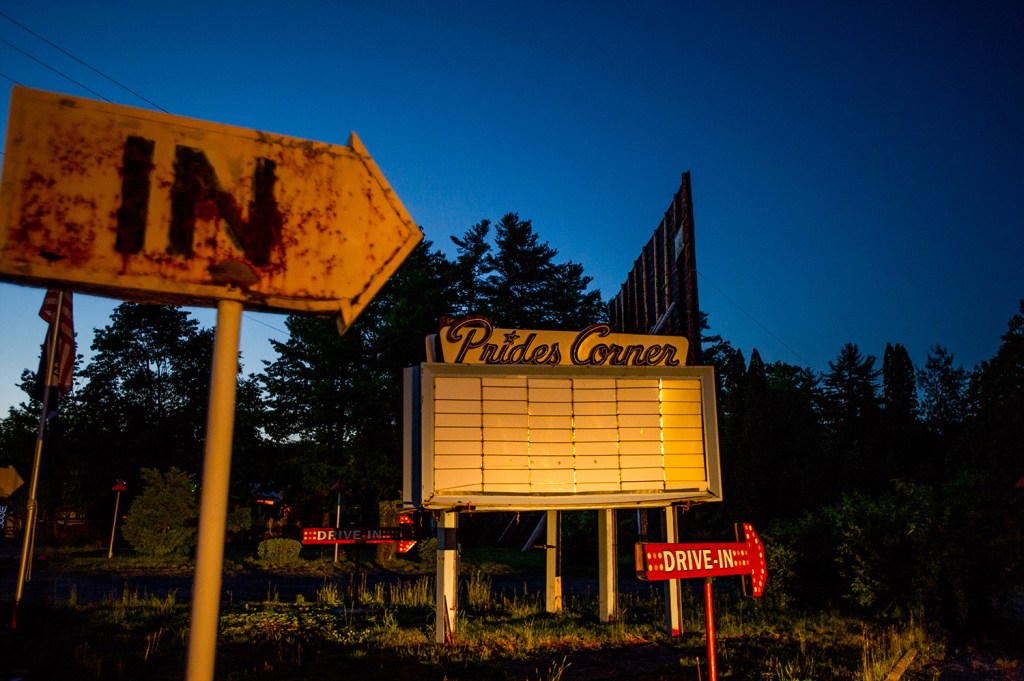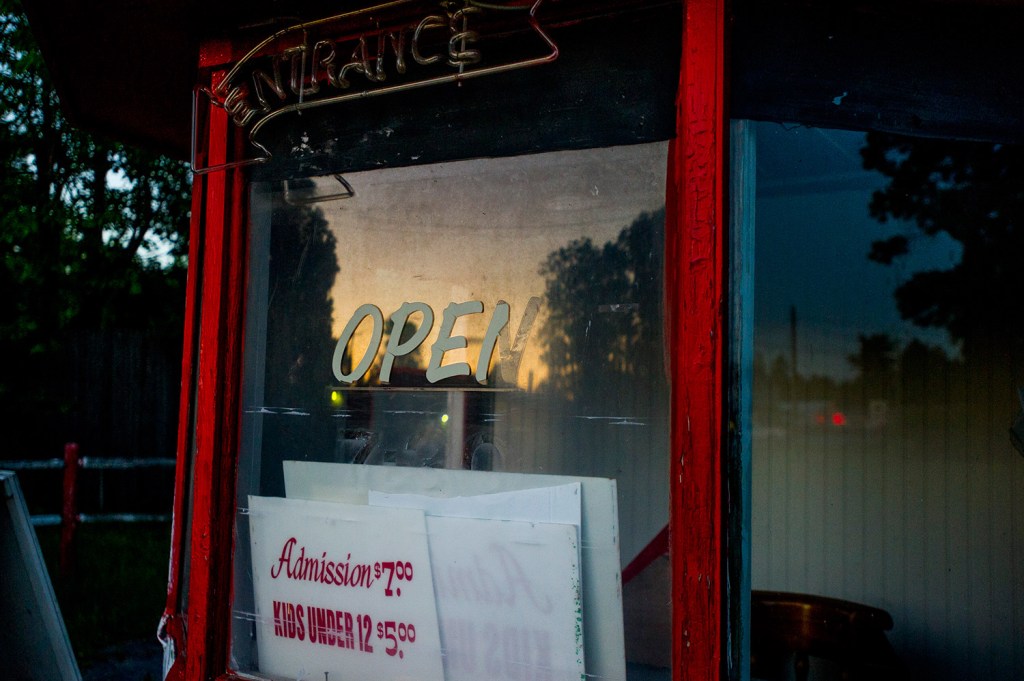Prides Corner Drive-In has been a local landmark on Route 302 in Westbrook for 63 years, a place where the family can crowd into the car with blankets and pillows and watch the latest blockbuster. It’s set up to show movies the old-fashioned way, on film.
And that’s in large part why Prides Corner Drive-In has not opened this year.
Thelma Tevanian, wife of 89-year-old founder John Tevanian, said the business is going through a “family restructuring” and will reopen eventually. She didn’t want to discuss details of the changes or predict when it might reopen.
The nation’s remaining 340 drive-ins have been scrambling to convert to digital projection in recent years, as film distributors have nearly phased out film prints in favor of much cheaper digital copies. Of Maine’s six drive-ins, four have converted to digital. Prides Corner has not. One other, Skowhegan Drive-In Theatre, hopes to convert but had to delay its opening by several weeks this spring.
During the past two years, there has been an online effort to raise funds for new digital projection equipment at Prides Corner Drive-In, featuring video and pleas written by the Tevanians’ son, Andrew. But Thelma Tevanian said last week she and her husband would rather people disregard that effort. They had also expressed that sentiment in more detail on the theater’s Facebook page in late May.
“From the beginning we are family owned and operated, and as with all families, changes occur. We are in the process of setting a path for the future,” the message read. “None of our decisions are dependent on fundraising or solicitations of any kind. This is in direct opposition to our fundamental beliefs and no one has the ability to act on our behalf.”
The Facebook post also invited people to come back “when we resume playing film and open our snack bar,” and thanked people for their interest and support.
NOSTALGIA MEETS THE DIGITAL AGE
Americans fell in love with the idea of watching movies in their own cars shortly after the first drive-in opened in New Jersey in 1933. By the late 1950s there were more than 4,000 drive-ins across the United States. Maine had about four dozen at various times, most of which are long gone, according to the website Drive-Ins.com.
Maine has twice as many drive-ins today as any other New England state, according to Drive-Ins.com. Massachusetts, Connecticut, New Hampshire and Vermont each have three. Rhode Island has one.
Television, changing tastes and other entertainment options caused the number of drive-ins to dip to about 1,000 by the 1980s and 400 by the 1990s. Nostalgia and a new generation of drive-in fans have helped the number stay fairly steady, at around 340. Part of the reason is cost: Going to the drive-in is cheap family entertainment. Most drive-ins charge by the carload, so a family can catch a double feature for $15 or $20.
The conversion to digital projection equipment, which costs around $65,000 or $75,000 per projector, has been a major hurdle for drive-ins. Since the late 1990s, film studios have been switching from film prints to digital copies, which cost much less to produce, said Patrick Corcoran, vice president and chief of communications for the National Association of Theatre Owners. A 35 millimeter print of a movie costs about $1,200; a digital copy runs about $60. Because studios might send out thousands of prints of each movie, the change to digital prints and digital projection saves the film studios billions of dollars each year, Corcoran said.
For theaters, the benefit of digital is that the movie won’t degrade over time like film does, Corcoran said. For a while, drive-ins could get enough 35 mm films to keep operating. But it’s gotten to the point where drive-ins can’t find enough film prints to fill a season. This year Corcoran expects most studios won’t produce more than 100 film prints of any one movie. Major releases can play on 3,000 screens, he said. Corcoran estimates that only 2 or 3 percent of the nation’s 40,000-plus screens have yet to convert to digital.
NOT AN EASY BUSINESS TO RUN
The cost of converting to digital is significant for drive-ins, which are seasonal businesses in this part of the country. Costs are high, and profits are low. Many owners say they stay in it for love or because they grew up in the business.
D. Edward Vogel, administrative secretary of the United Drive-In Theatre Owners Association, said most drive-ins need to make their money off concessions. That’s not an easy thing to do, since many people feel comfortable bringing in their own food. Drive-ins used to make more money from ticket sales, he said, but film distributors today get the “lion’s share” of that revenue.
“It’s a precarious business,” said Vogel, who owns Bengie’s Drive-In in Middle River, Maryland. “We’re very dependent on the weather, on studio release dates, on crowds coming out. If running a drive-in was easy, you’d see the big boys (corporations) get involved, but they’re not.”
Don Brown, owner of the Skowhegan Drive-In on Route 201, had planned to open this spring showing 35 mm films as usual. He planned to open in April and show “Captain America: Civil War” but could not get film prints from Disney. (No one from Disney replied to emails seeking comment.) Now he is focusing on converting his theater to digital and is accepting donations to offset costs.
The owners of the Skylite Drive-In in Madawaska were in the process of converting this past week. The Saco Drive-In and the Bridgton Twin Drive-In both converted a couple of years ago. The Bangor Drive-In, which opened in 2015 on the site of a drive-in that had been closed for 30 years, also has digital equipment.
Over the past few years some major studios offered financial help to theater owners to install digital equipment, including drive-in owners, but those offers have ended, Corcoran said. The programs usually were a fee paid to theater owners when they took a digital print to show.
The fees continued for a specific time period and a theater owner could get reimbursed for as much as 80 percent of the projector cost, said Vogel, of the drive-in owners’ association. But then there are other costs, including updating projection booths so that computer equipment can be installed in them. Plus, drive-in owners still have to come up with the money upfront.
“It’s not easy for a drive-in owner to get $75,000 upfront,” Vogel said. “They can’t always get the bank to understand the need.”
FAMILY BUSINESS SPREADS OUT
The Bridgton Twin Drive-In is owned by John S. Tevanian, another son of Thelma and John Tevanian. He says his parents are the sole owners of Prides Corner Drive-In but that he helps them when asked.
He had planned for the digital conversion of the Bridgton drive-in for years, putting money aside when he could. His father bought Bridgton Twin in 1971. He began leasing it from his father in 1996 and eventually bought it. The theater caters to tourists and summer vacationers in the Lakes Region, and does well enough that Tevanian added a second screen in 2000.
Besides converting to digital, the younger Tevanian also in the past couple of years has built new concession and restroom facilities. He said the projects combined probably cost $500,000 or more.
“I’ll probably never see a reasonable return on that, but I was born into this business. I’d rather do this than walk away and wonder in 20 years ‘what if,’ ” said Tevanian, 48.
Tevanian said his uncle Herbert Tevanian ran the Prides Corner Drive-In until the early 2000s, when one of the screens collapsed. At that point, Tevanian said, his father took over running it.
Fans of Prides Corner have been asking on Facebook when the theater will open, and expressing their affinity for the place. “Can’t imagine a summer without Prides Corner,” one post read. “Love you guys,” read another.
Dave VanSteemburg, a social worker from Limerick, posted some of his ideas for adding a little excitement to the place, including showing concert films.
“I just love the whole idea of drive-ins, the atmosphere, being outdoors,” said VanSteemburg, 47. “I have a lot of memories of Prides Corner. I would love to see it reopen.”
Send questions/comments to the editors.


